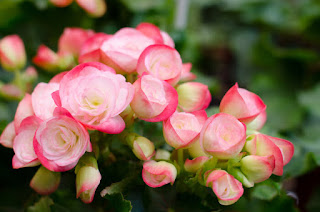 If you have ever seen chives blooming you may have been
surprised to find that the plant is as ornamental as it is useful in the
kitchen. Most gardeners do not realize that many members of the onion family
produce flowers pretty enough to grow in gardens. They are a very diverse
group, with flower clusters in many sizes, shapes and colors and blooming times
range from spring to summer to fall. The one thing they have in common is an
oniony smell when the foliage is rubbed or stepped on, but this does not happen
often enough to offend, and some of the flowers are sweetly fragrant. Most of
them make fine, long lasting cut flowers, and some every dry well for winter arrangements.
If you have ever seen chives blooming you may have been
surprised to find that the plant is as ornamental as it is useful in the
kitchen. Most gardeners do not realize that many members of the onion family
produce flowers pretty enough to grow in gardens. They are a very diverse
group, with flower clusters in many sizes, shapes and colors and blooming times
range from spring to summer to fall. The one thing they have in common is an
oniony smell when the foliage is rubbed or stepped on, but this does not happen
often enough to offend, and some of the flowers are sweetly fragrant. Most of
them make fine, long lasting cut flowers, and some every dry well for winter arrangements.
A wonderful allium to try is Allium giganteum “giant garlic”.
In early summer it sends up long stalks about 4 feet tall, topped with 5 inch
balls, perfectly round, made up of tiny purple flowers. Buy the time they bloom
there is little or no foliage around the stems, so grow them together with
lower, bushy plants or behind a low wall. If you like big, round purple
flowers, you will really love A. albopilosum “A. christophii” commonly called “star
of Persia”. Its flower cluster is looser than that of A. giganteum and up to a
foot in diameter, with star shaped flowers in late spring. Stems are shorter,
about 2 feet.
A.aflatunense has 4 inch purple balls in May and grows to 2
feet or a bit more. Other handsome spring alliums include A. moly “golden
garlic”, with flatter clusters of yellow flowers, about a foot tall, and A.
neapolitanum “daffodil garlic”, which is roughly the same height and bears
fragrant white flowers in April. For late summer bloom, A. tuberosum “Chinese
chives or garlic chives”, which has white, fragrant flower clusters. For fall
try A. stellatum or A. thunbergii, both short stemmed and pink flowering. Most
alliums are hardy to Zone 4, A. neapolitanum is hardy to Zone 6.
 Moreover, if you want to grow Allium then this plant like
full sun, though A. giganteum will do fine in part shade. Soil can be of
average fertility but it should be lightened with organic matter and moist but
well drained. They can be planted in spring of fall, from bulbs or from seed though
seed grown plants may take a long time to reach flowering size. Plant the short
ones about 4 inches apart, the tall ones 8 inches to a foot apart.
Moreover, if you want to grow Allium then this plant like
full sun, though A. giganteum will do fine in part shade. Soil can be of
average fertility but it should be lightened with organic matter and moist but
well drained. They can be planted in spring of fall, from bulbs or from seed though
seed grown plants may take a long time to reach flowering size. Plant the short
ones about 4 inches apart, the tall ones 8 inches to a foot apart.
A few things are very important to watch for; some alliums
should be deadheaded to prevent them from self sowing all over the place. They also
propagate themselves by forming little bulblets on the sides of the bulbs by
which you can increase your stock if you so desire. A friend of mine cautions
me that his A. giganteum did not produce flowers the second year becaust its
energy had gone into producing the bulblets, although by the third year the
bulblets were large enough to flower. So if your allium gives you foliage but
no flowers, be patient; it may perform better in the future. Also note that
many spring flowering species are summer dormant, so don’t be alarmed when the
foliage disappears.

